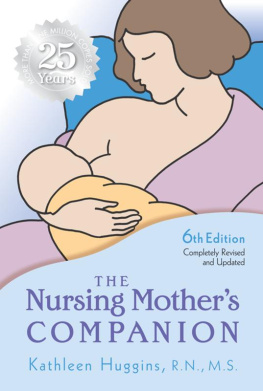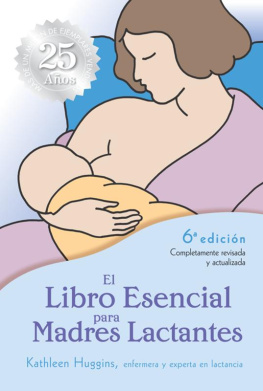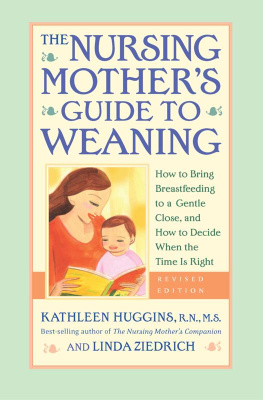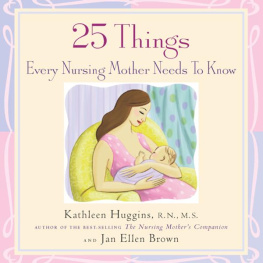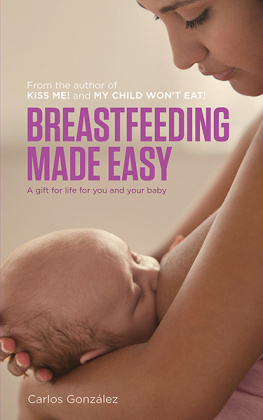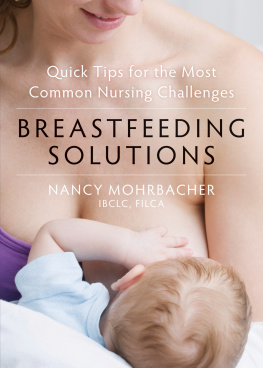To the nursing mothers of San Luis Obispo,
who have been my teachers
The Harvard Common Press
535 Albany Street
Boston, Massachusetts 02118
www.harvardcommonpress.com
Copyright 2010 by Kathleen Huggins
All rights reserved. No part of this publication may be reproduced
or transmitted in any form or by any means, electronic or mechani
cal, including photocopying, recording, or any information storage or
retrieval system, without permission in writing from the publisher.
Printed in the United States of America
Printed on acid-free paper
Library of Congress Cataloging-in-Publication Data
Huggins, Kathleen.
The nursing mother's companion / Kathleen Huggins ;
foreword by Ruth A. Lawrence. 6th ed.
p. cm.
Includes bibliographical references and index.
ISBN 978-1-55832-720-7 (pbk. : alk. paper)
1. BreastfeedingPopular works. I. Title.
RJ216.H845 2010
649'.33dc22 2010005981
Special bulk-order discounts are available on this and other Harvard
Common Press books. Companies and organizations may purchase
books for premiums or resale, or may arrange a custom edition, by
contacting the Marketing Director at the address above.
Interior design by Cia Boynton; modified by Vicki Rowland
Cover design by Night & Day Design
Illustrations by Susan Aldridge and Arden Vincent
10 9 8 7 6 5 4 3 2 1
Foreword
Centuries ago few women faced decisions about how to feed their babies: the newborn's only means of survival was mother's milk. Today, however, there are safe alternatives to nursing, and so a woman needs to think about how she wishes to feed her baby and what method is really best for them both. If she decides to nurse her baby as her ancestors did theirs, she must make an effort to learn how. Breastfeeding is the physiologic continuation of the normal reproductive cycle, and babies are born knowing how to find the nipple and to suck; their mothers, however, do not instinctively know how to nurse. Many women today have never seen a baby breastfed and have little access to experienced nursing mothers. Today's mothers have to learn what to do.
An expectant mother must first learn about alternative feeding methods so she can make an informed choice. With this book, Kathleen Huggins helps the mother through the decision-making process by providing sound information about the practical advantages of breastfeeding, its importance to a baby's health, and the very special emotional rewards it offers both mother and baby.
As a woman progresses through her pregnancy and makes preparations for her baby, she may wonder how she should also prepare for breastfeeding. Inexperienced though well-meaning friends may offer abundant but conflicting advice. This book, on the contrary, provides sensible guidelines for preparing to breastfeed, as well as an explanation of the process by which nature prepares the breast for nursing. Understanding how the breast functions prepares a woman for the physiologic changes that occur as the baby is born, the placenta is delivered, and lactation begins. It is also important that the expectant mother discuss her plans to breastfeed with her physician or midwife. The health-care provider can work together with the mother to plan the details of delivery and postpartum care to facilitate lactation.
Having made the decision to breastfeed and having prepared herself for it, a woman must learn how to nurse her new baby. Included here are chapters that cover methods of increasing milk production and release, or let-down, and what to do when small problems arise. The author also describes more complicated problems, though these are rare, and explains the course of treatment a doctor or midwife is likely to recommend. It is important to recognize when a situation warrants medical attention, since early appropriate management can usually minimize a problem and facilitate its resolution.
The author, who has breastfed her own children, is also a perinatal nurse who has counseled thousands of new mothers through a breastfeeding clinic and telephone hot line. With her practical experience, enhanced by her formal study of lactation, she is especially qualified to prepare this manual for mothers.
A new mother needs to be confident that she is doing the best for her baby. This book will give her the knowledge that is vital to developing that confidence. With the rich store of information herein, every mother should be able to experience the joy of breastfeeding.
Ruth A. Lawrence, M.D.
University of Rochester
Preface
Not long ago, a first-time nursing mother came to me about a difficulty she was having breastfeeding her baby. After we successfully resolved it, she suggested I write a book on breastfeeding that included problem-solving techniques. Although I was flattered, such a project seemed monumental. But later, as I recalled her enthusiasm, I began to consider the insights I had gained over years of assisting so many mothers, first as a maternity and newborn nurse and later after founding a breastfeeding clinic and telephone counseling service. Certainly, I was more than familiar with the common concerns of mothers who are learning to breastfeed, as well as with the occasional problems that can interfere with the development of a successful nursing relationship. The next day I wrote my rough outline.
Many excellent books had already been written on the benefits of nursing over artificial feeding methods. I set out, however, to provide mothers with a practical guide for easy reference throughout the nursing period. The first part of the book provides basic information about the breast, preparation for nursing, and nursing during the first week; the remainder of the book is intended for reading as the baby and the nursing relationship grow and develop. There are chapters on each of the three later phases of nursingfrom the first week through the second month, from the second month through the sixth, and after the sixth month. Following each of these chapters is a Survival Guidea quick yet thorough reference for almost any problem you or your baby may encounter during the phase covered. Although you may rarely need to consult the Survival Guides, I have included them to ensure that, when you do, you will be able to identify and resolve your problem as quickly as possible. Because many nursing women occasionally find themselves in need of medication, Dr. Philip O. Anderson has provided an appendix on drugs and their safety for the breast-fed baby.
During the year I spent writing this book, I received a great deal of encouragement and guidance. I am tremendously indebted to LynnMoen for her support along the way. I also wish to thank Penny Simkin, R.P.T., and my editor, Linda Ziedrich, for their many efforts on my behalf.
For their thoughtful review of the text I thank Marian Tompson; Andrea Herron, R.N., M.S., C.L.C.; Kathleen Rodriquez Michaelson, B.A., C.L.C.; Vicki McDonald, R.D.; Judith La Vigna; Julie Merrill, R.N.; Tom Robinson; and Kathleen Auerbach, Ph.D.
Jim Litzenburger; Vicki Gadberry, R.N., C.N.M.; Marilynn Schuster, R.N.; Kathleen Long, M.D.; and Dawn Edwards, R.N.C., are most appreciated for their encouragement as well as their friendship.
I am grateful to Donna Janetski for her commitment to this project in preparing the manuscript. My thanks also to Mike Sims for his generosity, and to Susan and Kirk Graves for their efforts.
This book would never have been possible without my husband, Brad, whose love, patience, and faith sustained me. Kate, my beautiful daughter and former nursing companion, was my inspiration throughout.
N OTE TO THE S ECOND E DITION : For help in preparing this edition I would like to thank Trina Vosti, I.B.C.L.C., and Andrea VanOutryve, I.B.C.L.C. And thanks to John, my current nursing companion.
Next page
